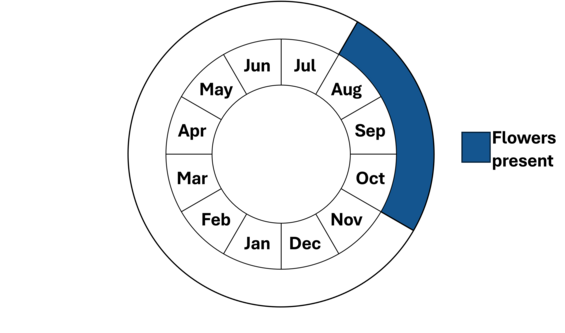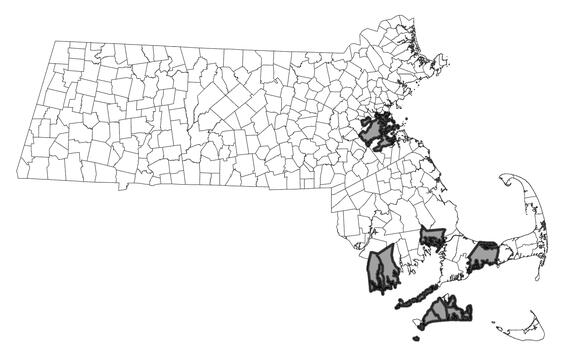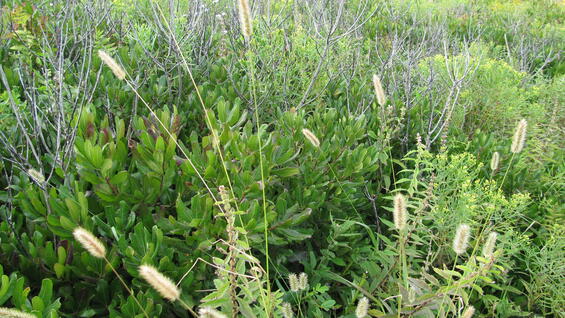- Scientific name: Setaria parviflora (Poir.) Kerguélen
- Species of Greatest Conservation Need (MA State Wildlife Action Plan)
- Special Concern (MA Endangered Species Act)
Description
Inflorescence with golden bristles in the fall. Photo credit: Jennifer Garrett
Bristly foxtail (Setaria parviflora) is a perennial, rhizomatous grass (family Poaceae) of coastal habitats such as salt marsh and salt pond margins. Its most recognizable feature is its spike-like panicle that is exceptionally dense with golden bristles.
Bristly foxtail grows from short, hard, knotty rhizomes which may reach up to 4 cm (1.5 in) in length; its alternative common name is “knotroot foxtail.” The hairless stems are 30-120 cm (12-47 in) tall with narrow (2-8 mm [0.08-0.3 in]), sand-papery leaves reaching 25 cm (10 in). The 3-10 cm (1.25-4 in) unbranched, spike-like inflorescence is lined with very small (2-2.5 mm) flower clusters, called spikelets in the grasses. The glumes are unequal and veined, the lower third of the spikelet has three veins and the upper half to two-thirds of the spikelet has five veins. The lower florets commonly have male flowers only (i.e., they are staminate). The lemmas are wrinkled horizontally (rugose), especially the upper lemmas, which can also be purplish at the apex. The common name bristly foxtail is derived from the four to twelve bristles at the base of each spikelet. The 2 to12 mm (0.08 – 0.5 inches) straw-colored to pale yellow bristles have minute barbs along their length. This species is best observed in late summer and autumn, though it is often identifiable earlier and later in the year.

Hard, knotty rhizome. Photo credit: Jennifer Garrett
The very common yellow foxtail or pigeon grass (Setaria pumila ssp. pumila) is an exotic species that is most similar to bristly foxtail, as it is the only other species to share the trait of numerous bristles at the spikelet base; however, it is a tufted annual that has fibrous roots and lacks a rhizome. Further, it is more of a generalist, known commonly from waste places and roadsides. All other foxtail grasses known from New England are also exotic annuals, but have fewer bristles per spikelet, and usually longer inflorescences than bristly foxtail and yellow foxtail.
Life cycle and behavior
Bristly foxtail is a perennial, rhizomatous species and will form dense colonies in appropriate habitat. It will produce a stem with florets and seed from August through October. The bristles at the base of the spikelets may help the seed be transported in fur or feathers to new locations. Otherwise seed falls near the parent plant.

Population status
Bristly foxtail is listed under the Massachusetts Endangered Species Act as special concern. All listed species are protected from killing, collecting, possessing, or sale and from activities that would destroy habitat and thus directly or indirectly cause mortality or disrupt critical behaviors. There are currently 20 known occurrences in the state verified since 1999. It is currently known from Barnstable, Bristol, Dukes, Norfolk, Plymouth, and Suffolk Counties, and is historically known from Nantucket County.

Distribution in Massachusetts
1999-2024
Based on records in the Natural Heritage Database
Distribution and abundance
Bristly foxtail is distributed throughout the United States except northern New England, the upper Midwest, and northern Plains states. Its range continues south through Central America and all of South America (POWO 2025). In New England, in addition to being special concern in Massachusetts, it is endangered in Rhode Island, not ranked in Connecticut, and not present in Maine, New Hampshire or Vermont (NatureServe, 2025).
Habitat
Bristly foxtail is found in scattered colonies, most often in linear patches along the upper borders of salt marshes, estuaries, and salt pond margins out of normal tidal reach. It can also be found in disturbed sandy areas such as the edges of roads and paths in or near salt marshes, and in coastal meadows and back dunes.
Associated species include saltmarsh hay (Spartina patens), switchgrass (Panicum virgatum), saltmarsh elder (Iva frutescens), slender-leaved goldenrod (Euthamia caroliniana), sea lavender (Limonium carolinianum), bayberry (Morella caroliniensis), and eastern red cedar (Juniperus virginiana).
Healthy habitats are vital for supporting native wildlife and plants. Explore habitats and learn about conservation and restoration in Massachusetts.

Habitat mixed with other coastal species including bayberry. Photo credit: Jennifer Garrett
Threats
As bristly foxtail frequently occurs just above the normal high-tide line, it is particularly susceptible to increased inundation due to predicted sea level rise (Staudinger et al. 2024). This is its primary threat in Massachusetts. Other threats include encroachment by woody species and exotic invasive plants and trampling by foot traffic or vehicles on actively used trails and roads.
Conservation
Survey and monitoring
Bristly foxtail is a perennial species that typically will remain in the same location for years. Regular monitoring should occur every 5 to 15 years, with an increase in timing of monitoring if sea level rise increases quickly. The focus should be on changes in its habitat, including shade, invasive species and changes due to a higher high tide line. As a rhizomatous species, a count of ramets or an areal coverage is helpful in assessing the species. The best time to survey for it is from August through October.
Management
If regular monitoring detects that invasive plant species are becoming a threat to populations of bristly foxtail, plans should be developed to control the invasive species. If there are trails or roads going through populations leading to trampling of plants, such trails should be moved upgradient, if possible, to no longer impact the plants and the section through the population should be closed. Mowing tends to favor this species, along with other grasses, and sites should be monitored to ensure ongoing management that supports grasses over shrubs. Mowing may be considered to expand favorable habitat at known locations. All active management of rare plant populations (including invasive species removal) is subject to review under the Massachusetts Endangered Species Act and should be planned in close consultation with MassWildlife’s Natural Heritage & Endangered Species Program.
Research needs
Research is needed to determine whether bristly foxtail can be grown in a nursery or garden setting for purposes of reintroductions. Questions about seed germination and seed storage over winter will need to be answered. As sea-level rise may create new habitat while at the same time isolating current populations, this strategy for reintroductions could prove useful to long-term conservation of this species.
References
Gleason, Henry A., and Arthur Cronquist. Manual of Vascular Plants of Northeastern United States and Adjacent Canada, Second Edition. Bronx, NY: The New York Botanical Garden, 1991.
Haines, Arthur. Flora Novae Angliae. New England Wild Flower Society, Yale University Press, New Haven, CT. 2011.
Magee, Dennis W. Grasses of the Northeast. University of Massachusetts Press, Amherst, Massachusetts. 2014.
Native Plant Trust. 2014. NORM Phenology Information.
NatureServe. 2025. NatureServe Network Biodiversity Location Data accessed through NatureServe Explorer [web application]. NatureServe, Arlington, Virginia. Available https://explorer.natureserve.org/. Accessed: 3/18/2025.
POWO (2025). "Plants of the World Online. Facilitated by the Royal Botanic Gardens, Kew. Published on the Internet; https://powo.science.kew.org/ Retrieved 3/18/2025."
Staudinger, M.D., A.V. Karmalkar, K. Terwilliger, K. Burgio, A. Lubeck, H. Higgins, T. Rice, T.L. Morelli, A. D'Amato. 2024. A regional synthesis of climate data to inform the 2025 State Wildlife Action Plans in the Northeast U.S. DOI Northeast Climate Adaptation Science Center Cooperator Report. 406 p. https://doi.org/10.21429/t352-9q86
Contact
| Date published: | May 12, 2025 |
|---|